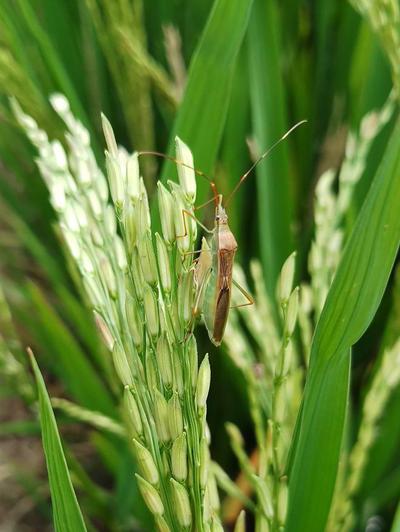Rice Bug
Leptocorisa spp.
Insect
In a Nutshell
- Feeding damage on head.
- Unfilled or empty grains.
- Discoloration.
- Grain deformation.
- Confusion with Bacterial Panicle Blight.
Can also be found in
Symptoms
Depending on the growth stage of the rice grain, the feeding can result in empty grains or small, shriveled, deformed grains with a spotty discoloration, sometimes with an offensive smell. Panicles appear erect.
Recommendations

Organic Control
Spray aromatic (like lemongrass) soap solution to expel the rice bug. Use “prahok” (local ‘cheese’ in Cambodia) near the field to attract the rice bug and kill it. Use a mosquito net in the early morning or late afternoon to remove the rice bug, crush it and put it in water then spray it to expel other rice bugs. Encourage biological control agents: some wasps, grasshoppers, and spiders attack rice bugs or rice bug eggs.

Chemical Control
Always consider an integrated approach with preventive measures together with biological treatments if available. The benefits of using an insecticide must be weighed against the risks to health and the environment. Spray chlorpyriphos 50 EC at 2.5 ml in the evening hours by starting from the field edges to the center in a circular manner. This brings the bugs to the center and allows to manage them effectively. Alternatively you can also use abamectin. Indiscriminate insecticide use disrupts biological control, resulting in pest resurgence.
What caused it?
Rice bugs occurs sporadically during milking to grain filling stage only and emanate foul smell in the evening hours. Immature and adult rice bugs both feed on rice grains. Rice bugs suck out the contents of developing grains. They are actually found in all rice environments. Woodlands, extensive weedy areas near rice fields, wild grasses near canals, and staggered rice planting favors high population densities. They are more active when monsoonal rains begin. Warm weather, overcast skies, and frequent drizzles favor its population build-up. They are less active during the dry season. The symptoms resemble the damage of Bacterial Panicle Blight.
Preventive Measures
- If possible, use late-maturing varieties to avoid peak populations.
- Synchronous planting also helps to reduce rice bug problems.
- Monitor fields for signs of the pest, starting from pre-flowering stage.
- Remove alternative hosts such as crabgrass, goosegrass and beans.
- Remove weeds from fields and surrounding areas.
- Use trap crops around the field to attract rice bugs.
- Apply a balanced fertilization plan.
- Water regularly but avoid excessive humidity.
- Use nets to capture rice bugs, in the early morning or late afternoon.
- Flood fields to drown the bugs or drive them to the top of the plant, where they are more easily targeted by pesticides.
- Preserve beneficial insects by spraying less broad-spectrum insecticides (wasps, grasshoppers and spiders).



